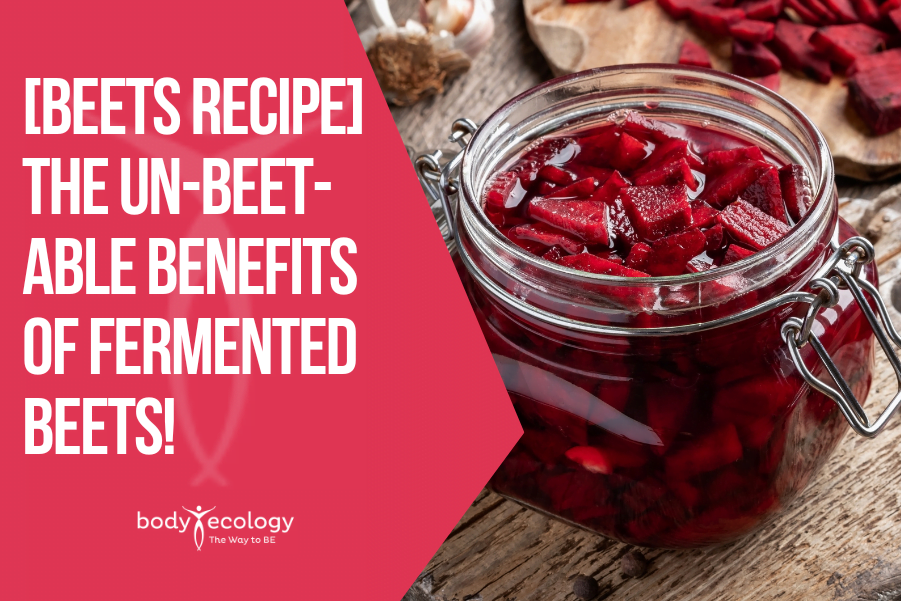[Beets recipe] The Un-beet-able Benefits of Fermented Beets!

Now is a great time to enjoy seasonal root vegetables like squash, carrots, parsnips, and… fermented beets! They all make for an attractive side dish when thinly sliced or grated. But remember, all foods have a front and a back, and some root veggies, like parsnips and beets, are very sweet.
Carrots, beets, and parsnips are popular for juicing, but when you juice a vegetable or fruit and remove the fiber, that veggie or fruit will become even sweeter — a no-no for controlling your blood sugar levels.
It’s not an understatement to say we’re big on beets. Balanced blood pressure and an energy boost are just some of the many benefits you may get from our BeetBiotic™.
If you’re dealing with an infection like candida, Lyme, or mold or a viral or bacterial infection, you must eliminate any form of sugar from your diet in order to bring that infection under control. When you roast or bake these veggies, they become sweeter; so cooking in water or steaming them is a better choice.
But the good news is… they’re great for fermentation!
At Body Ecology, we love beets, but how you prepare them is key. As with many foods, the nutrients in fresh beets are better preserved and even enhanced when beets are cultured.1 Fermentation can “amplify the specific nutrient and phytochemical content of foods” and even create new phytochemical compounds with benefits for health.2 Beets become nutrition superstars when fermented!
Other Benefits
Beets are one of the highest food sources of nitrates, which are converted by your body into nitric oxide (NO).
NOtorious for supporting healthy blood pressure, NO helps blood vessels to dilate, i.e., relax.
This allows more space for blood to flow, resulting in better oxygenation of tissues and better delivery of nutrients to all the cells in your body.3
Beets are so good for you, in so many ways, that the authors of a 2018 systematic review said beets “should be promoted as a key component of a healthy lifestyle.”4 Here at Body Ecology, we agree but note that beets are very high in oxalates.
Oxalates cause stones — in the kidneys, thyroid, muscles, joints, and other tissues. Oxalates can be found in many of our favorite plant foods. Green and black tea, numerous nuts and seeds, almond and cashew milk, spinach, sweet potatoes, and chocolate are a few examples.
For various reasons, hundreds of millions of people suffer from local or systemic yeast infections today. While diet is a main cause of oxalate stones, if you struggle with a yeast infection, yeast has a gene that makes oxalates. So, even with their wonderful nutritional benefits, this superstar vegetable may not be right for you. Not so if it is fermented!
Fermenting Beet Juice and Fresh Beets.
Fermented beets are packed with beneficial bacteria that help promote digestion and good gut health. Fermentation also helps reduce levels of antinutrients, such as phytates and oxalates, found in many vegetables. By reducing or eliminating phytates, we can better absorb important minerals like iron, calcium, and zinc.5,6
You can ferment fresh beets, and you can also ferment their juice.
If you’re avoiding alcohol, fermented beet juice, commonly known as kvass is a delicious alternative, so serve it in a pretty wine glass. You can also use kvass as a cocktail mixer, and you can cook with it, using it like cooking vinegar, adding it to salad dressings, or mixing it into soups like borscht. (But, cooking with kvass at a higher temperature destroys the wonderful diversity of beneficial microbes, so add it after the soup has cooled.)
And, a straight shot of fermented beet juice is a great daily tonic! Just like beets, beet juice has a delightful, earthy flavor with a hint of sweetness. When fermented properly, beet juice is also a little salty and sour and packed with probiotic goodness.
Beets are very sweet, so be sure to ferment the juice long enough so that it becomes sour, indicating that the sugar has been mostly consumed by the beneficial microbes. As a brand-new study found, calcium, iron, and zinc can significantly increase — allowing for better bioavailability and higher mineral uptake — with fermentation.7
How to make fermented beet juice: It’s easier than you think
Beet kvass is very easy and affordable to make at home and can be ready in just a few days or a week. The process is very similar to making sauerkraut, kimchi, or traditional dill pickles and uses fermentation by Lactobacillus bacteria.
To make kvass:
1. Clean and trim the beets, keeping the skins on but scrubbing well.
2. Cube the beets to about a half-inch or smaller.
3. Place the beets in quart-size jars and sprinkle with salt (1 to 2 teaspoons per 12 ounces of beets).
4. Add slices of fresh ginger, lemon rind, orange rind, and spices (optional).
5. Combine one packet of our Body Ecology Culture Starter™ with enough water to cover the beets but with about an inch of headspace in the jar.
6. Cover the jar and leave at room temperature but out of direct light.
7. Put a plate or bowl under the jar to catch any brine that bubbles out.
Over the next two to three days, the Lactobacillus plantarum bacteria in the starter and the bacteria naturally present on the beets will work their magic, eating the beet sugars to create a more acidic environment. This allows the beneficial bacteria to rapidly reproduce, leaving you with a delicious, probiotic-rich kvass after a few days to a few weeks.
Open the jar once a day to test the brine and release any gases given off during fermentation. If a skin has formed on the top, skim it off.
Once the beet brine is to your taste, strain and transfer the liquid to a new (sterile) jar and store this in the refrigerator to slow down further fermentation. You can add the beet kvass to a soup or smoothie. Or, throw everything into a blender at this stage and make a big batch of smooth and tasty — but thicker — fermented beet juice.
Pro tips to ferment beets or beet juice with a higher microbial content
Fresh beets bring their own friendly bacteria into the mix, so it’s not always necessary to add a starter culture to your beets.
However:
To make sure your beets get a good start with a hardy strain of beneficial bacteria, you can use Body Ecology’s Cultured Vegetable Starter, which contains a very robust bacterium called Lactobacillus plantarum. Plantarum is a superstar among bacteria and encourages a greater variety and number of other microorganisms to grow.
It’s best when fermenting at home to use non-iodized salt that is free of anti-caking agents and to use distilled or filtered water, especially if your tap water is chlorinated.
Top tip: Don’t shred the beets! This creates too much surface area for bacteria, leading to rapid fermentation and the production of alcohol!
And, if the process of fermenting beets feels a little too daunting, or you don’t have the countertop space or local fresh beets right now, consider Body Ecology’s BeetBiotic™, a powerful Limited Edition probiotic “gut shot” using beets, along with fennel and maqui berry for extra antioxidant activity.
Perfect for braving a family holiday, switch booze for beets and, among other things, help build your immune system and keep your blood pressure under control.8,9
REFERENCES:
- 1. Kim, B., Minsu Hong, V., Yang, J., et al. (2016). A Review of fermented foods with beneficial effects on brain and cognitive function. Prev Nutr Food Sci, 21(4), 297-309.
- 2. Selhub, E.M., Logan, A.C. & Bested, A.C. (2014). Fermented foods, microbiota, and mental health: ancient practice meets nutritional psychiatry. Journal of Physiological Anthropology, 33(1), 2.
- 3. Kapil, V., Khambata, R.S., Robertson, A., Caulfield, M.J., and Ahluwalia, A. (2015). Dietary nitrate provides sustained blood pressure lowering in hypertensive patients: a randomized, phase 2, double-blind, placebo-controlled study. Hypertension, 65(2), 320–327.
- 4. Bonilla Ocampo, D.A., Paipilla, A.F., Marín, E., et al. (2018). Dietary Nitrate from Beetroot Juice for Hypertension: A Systematic Review. Biomolecules, 8(4), 134.
- 5. Humer, E. & Schedle, K. (2016). Fermentation of food and feed: A technology for efficient utilization of macro and trace elements in monogastrics. J Trace Elem Med Biol, 37, 69-77.
- 6. Sokrab, A.M., Mohamed Ahmed, I.A. & Babiker, E.E. (2014). Effect of fermentation on antinutrients, and total and extractable minerals of high and low phytate corn genotypes. Journal of Food Science and Technology, 51(10), 2608-2615.
- 7. Chawla P, Kumar V, Bains A, Singh R, Sadh PK, Kaushik R, Kumar N. Improvement of Mineral Absorption and Nutritional Properties of Citrullus vulgaris Seeds Using Solid-State Fermentation. J Am Coll Nutr. 2020 Sep-Oct;39(7):628-635. doi: 10.1080/07315724.2020.1718031. Epub 2020 Apr 7. PMID: 32255407.
- 8. Tripathi P. Nitric oxide and immune response. Indian J Biochem Biophys. 2007 Oct;44(5):310-9. PMID: 18341206.
- 9. A. J. Webb, N. Patel, S. Loukogeorgakis, M. Okorie, Z. Aboud, S. Misra, R. Rashid, P. Miall, J. Deanfield, N. Benjamin, R. MacAllister, A. J. Hobbs, A. Ahluwalia. Acute Blood Pressure Lowering, Vasoprotective, and Antiplatelet Properties of Dietary Nitrate via Bioconversion to Nitrite. Hypertension, 2008; 51 (3): 784 DOI: 10.1161/HYPERTENSIONAHA.107.103523.











